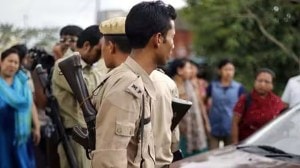- India
- International
Streetwise Kolkata: Why this Tagore scion got a road named after him in Kolkata
On a narrow lane in Pathuriaghata, named 'Prasanna Kumar Tagore Street', one can find remnants of the large “castle” that once belonged to the Tagores. The street is also locally known as “Tagore Castle Road”.
 10-minute walk from the famed Jorasanko thakurbari, the ancestral home of Rabindranath Tagore, is the former residence of another branch of the Tagore family — the Tagore Castle. (Express Photo: Shashi Ghosh)
10-minute walk from the famed Jorasanko thakurbari, the ancestral home of Rabindranath Tagore, is the former residence of another branch of the Tagore family — the Tagore Castle. (Express Photo: Shashi Ghosh)
Kolkata’s architectural heritage, much of it from the British Raj — especially when the city served as the capital of British operations in the region — earned it the name of “city of palaces”. It is not unusual to walk around north Kolkata and come across large mansions, built in a mix of architectural styles unique to Kolkata for various reasons.
A 10-minute walk from the famed Jorasanko thakurbari, the ancestral home of Rabindranath Tagore, is the former residence of another branch of the Tagore family, in Pathuriaghata in the northern part of the city. The Tagore family tree is complex and large, and this branch of the family came to be known as the Pathuriaghata Tagores, to distinguish them from the branch living at Jorasanko.
 Despite the building being in a state of disrepair, turrets on all sides of the house, a unique feature that compels people to call it a castle, are still standing, some barely holding on. (Express Photo: Shashi Ghosh)
Despite the building being in a state of disrepair, turrets on all sides of the house, a unique feature that compels people to call it a castle, are still standing, some barely holding on. (Express Photo: Shashi Ghosh)
On a narrow lane in Pathuriaghata, named ‘Prasanna Kumar Tagore Street’, one can find remnants of the large “castle” that once belonged to the Tagores. The street is also locally known as “Tagore Castle Road”.
On a weekday morning, a visit to the neighbourhood is a challenge. There are no pavements and the entire bylane is transformed into a local bazaar, with hawkers occupying every inch of the space, selling everything from vegetables to clothes, attracting throngs of buyers. Small local businesses have opened up on both sides of the road, dumping their refuse right beside their establishments.
Streetwise Kolkata: Simla Road has its origins in a flower

Still, as is the case with the city, for those seeking a bit of Calcutta’s history and heritage, the beauty is hard to miss.
Located only a few minutes from the mouth of the bylane is a curious structure, whimsical in its design and construction, not seen anywhere else in the city. Now dilapidated, it is the former home of the Pathuriaghata Tagores.
It is immediately evident why this large mansion is called a castle by locals — it was built like one. Decrepitude over the years has caused the building’s red brick exterior to be exposed to the elements, chipping away the chuna, slake lime, and paint that once coated it.
 Decrepitude over the years has caused Tagore Castle’s red brick exterior to be exposed to the elements, chipping away the chuna, slake lime, and paint that once coated it. (Express Photo: Shashi Ghosh)
Decrepitude over the years has caused Tagore Castle’s red brick exterior to be exposed to the elements, chipping away the chuna, slake lime, and paint that once coated it. (Express Photo: Shashi Ghosh)
A large PVC banner featuring West Bengal Chief Minister Mamata Banerjee in a Holi event advertisement hangs from the main entrance of the building. The structure has been overtaken by tenants and squatters, who, over the years, have made unauthorised changes to the interior and exterior of the building. Any plaques at the main entrance that may have provided information about its original residents have been removed, and it would be difficult to identify the building if one did not know of its history.
Built on a large plot in the heart of north Calcutta, the space occupied by the building is significant. Over the years, areas around the house — where a courtyard, a garden, staff’s quarters and garage may have existed — have been usurped and smaller buildings have come up within the property, almost forming a microcosm of its own.
Looking at the structures that have come up within the complex over the years, it is difficult to distinguish where the property begins and where it ends. Despite the building being in a state of disrepair, turrets on all sides of the house, a unique feature that compels people to call it a castle, are still standing, some barely holding on.
Streetwise Kolkata: Watgunge, where Colonel Henry Watson built a dock and a fortune
Windows inside the turrets show human habitation along with hordes of pigeons who’ve made crevices in the exterior their home. Winding staircases inside the building provide access to these turrets. An iron wind-vane shaped in the form of a dragon rests on the very crest of the building, with remnants of what was once a turret clock, broken and dismantled over the years.
In the jumble of tenants occupying the structure, some small, private commercial enterprises have also been operating. Mid-size trucks transporting cargo regularly stop here, entering the premise without any checks. There is no sign of any security personnel, or any information regarding who owns the property.
The neighbourhood of Pathuriaghata is one of the oldest in the city, and its origins can be traced to when the East India Company first started building Fort William in the late 1680s. The Tagores have always been one of the most prominent and wealthy families in the city, and their history is almost as old as that of Calcutta itself.
 The winding staircases inside Tagore Castle. (Express Photo: Shashi Ghosh)
The winding staircases inside Tagore Castle. (Express Photo: Shashi Ghosh)
Prior to the establishment of the city of Calcutta by East India Company employee Job Charnock, the Tagore family resided in the village of Gobindapur, that was later combined with the villages of Sutanuti and Kalikata to form the city.
In 1758, the Tagores of Gobindapur found themselves displaced when the British decided to clear the area to accommodate the sprawling grounds of Fort William. Many zamindari families like the Tagores were forced to move to other parts of the city, using financial compensation provided by the Fort William Council.
The patriarch of the Pathuriaghata branch of the Tagore family, Darpanarayan Tagore, laid the foundations of not only this branch, but also of the house that later came to be known as “Tagore Castle”.
Streetwise Kolkata: Khidderpore’s history is linked to the port and zamindari it absorbed
The street on which this house stands is named after one of Darpanarayan Tagore’s grandsons, Prasanna Kumar Tagore. There are no clear records concerning why the street was so named, but the nomenclature is unsurprising, because of the prominence of the Tagore family, especially the men, and their contribution to the city of Calcutta.
Prasanna Kumar Tagore was born in the thakurbari in Pathuriaghata on December 21, 1801, and was the youngest son of Gopi Mohan Tagore and Menoka Devi. Like other members of his family, he was well educated. He received private lessons at home from British teachers before going to Hindoo College, now Presidency University, an institution whose founding members included his father Gopi Mohan.
 In the jumble of tenants occupying the structure, some small, private commercial enterprises have also been operating. (Express Photo: Shashi Ghosh)
In the jumble of tenants occupying the structure, some small, private commercial enterprises have also been operating. (Express Photo: Shashi Ghosh)
Records at the Rabindra Bharati Museum at Jorasanko show that Prasanna Kumar Tagore was interested in mathematics, logic and law, pursuing the latter as full-time career. He was also well-versed in languages, having fluency in English, Persian and Sanskrit.
On March 10, 1817, he married at the age of 16. A little later, he was appointed the Dewan of Tamluk district and began overseeing the salt department. There are no records available for the nature of this department and the work he did in his role as Dewan. After resigning from this job, he began working with his relative, Dwarakanath Tagore — the founder of the Jorasanko branch of the Tagore family — at the Carr, Tagore and Company, the first managing agency run in the Indian subcontinent in equal partnership with a European.
Streetwise Kolkata: Suhrawardy Avenue… no, not named after the ‘Butcher Of Bengal’
Dwarakanath Tagore and William Carr founded this diversified business in 1834 and ran this operation from the headquarters in Calcutta. Records at the Rabindra Bharati Museum at Jorasanko indicate that Prasanna Kumar Tagore was involved in the locomotives division at this company, but there is no detailed information available. A few years prior to the establishment of Carr, Tagore and Company, Dwarkanath Tagore founded the Union Bank in Calcutta in 1829, at which he installed a 28-year-old Prasanna Kumar Tagore as one of the trustees.
The legal profession was Prasanna Kumar Tagore’s true calling, and he found his way back to it when he was appointed as a dewani lawyer for the British government at the Sudder Dewanny Adawlut. This job earned him success and significant wealth.
 The interior of the Tagore Castle. (Express Photo: Shashi Ghosh)
The interior of the Tagore Castle. (Express Photo: Shashi Ghosh)
Within the Tagore family, Prasanna Kumar is an interesting individual, because of his complex relationship with the British. Although he had a relatively mutual relationship of admiration with the British, there was also a streak of independence that made him impose his own thoughts and causes within the framework in which he coexisted with them.
During that time, Persian was the language used in the courts of the Sudder Dewanny. Prasanna Kumar used his resources and influence to petition for the inclusion of Bangla, so as to make things more accessible for ordinary people. Despite his affinity for the British and the speed at which he rose through the ranks in the Sudder Dewanny Adawlut, he wrote several essays in reformist newspapers championing this cause.
His efforts worked. In 1838, his petitions for the use of Bangla in the Adawlut were accepted.
Records at Jorasanko indicate that Tagore had a sharp memory and was known for remembering detailed information regarding legal cases. His renown drew people from near and far to seek his expertise in legal matters. When an English judge at the Sudder Dewanny Adawlut retired and returned to England, his name came up as a potential replacement, but this presumably did not materialise.
 A portrait of Prasanna Kumar Tagore: (Photo source: Rabindra Bharati Museum at Jorasanko)
A portrait of Prasanna Kumar Tagore: (Photo source: Rabindra Bharati Museum at Jorasanko)
The British were quick to recognise Prasanna Kumar Tagore’s legal prowess and in 1844, he was appointed a government lawyer for British authorities, a job that earned him a handsome annual salary of Rs 2,00,000. During this time, Tagore began purchasing large tracts of land in Calcutta and elsewhere, and managed to pay off debts that he had accumulated over the years. There is no information available regarding the nature of these debts.
He retired from the job of a government lawyer in 1850, but that was hardly the end of his association with the British government. In 1854, the Legislative Council of India was established and he was appointed a clerk assistant here, with a monthly salary of Rs 1,250.
Streetwise Kolkata: Upmarket Victoria Terrace was born out of a slum
Prasanna Kumar was a member of the conservation organisation, the Gaudiyo Samaj. But despite his conservatism, he supported Raja Rammohan Roy in several social reformist causes, like the abolition of sati.
Although he supported education, particularly women’s education, he had a complex relationship with the cause of the emancipation of women, because he didn’t necessarily believe in their complete liberation.
 On a weekday morning, the entire bylane is transformed into a local bazaar, with hawkers occupying every inch of the space, selling everything from vegetables to clothes, attracting throngs of buyers. (Express Photo: Shashi Ghosh)
On a weekday morning, the entire bylane is transformed into a local bazaar, with hawkers occupying every inch of the space, selling everything from vegetables to clothes, attracting throngs of buyers. (Express Photo: Shashi Ghosh)
Prasanna Kumar was a member of the Calcutta School Society and also served as a director of the Hindoo College, his alma mater, at one point in his life. Later, he served on the governing body of the Hindoo College and was instrumental in devising the course curriculum at the institution. When Hindoo College became a government educational institution, he left his position on the governing body. When Calcutta University was established in 1857, he joined it.
In his last will dated October 10, 1862, he bequeathed a sum of Rs 3,00,000 to Calcutta University, which was paid in a monthly sum of Rs 10,000 for a professorship titled the “Prasanna Kumar Tagore Law Professorship”. These funds also helped establish academic lectures in the Department of Law at the university. According to Soumitra Sarkar, Librarian at Calcutta University, these law lectures still continue at the university, and are popularly known as the Tagore Law Lectures. He died on August 30, 1868.
Although the street on which the ancestral house now stands is named after Prasanna Kumar Tagore, the “castle” was commissioned by his nephew Jatindramohan Tagore in 1895, demolishing the traditionally designed thakurbari that previously existed.
Jatindramohan requisitioned Macintosh Burn, a noted civil engineering company in British India, to construct the house, along the lines of England’s castles.
The wealth of the Pathuriaghata Tagores allowed them to commission their portraits, at a time when the practice was not widespread. What made the family’s portraits distinct even among the handful who did commission them was that they were done in the European style. In one room of Jorasanko today, a series of portraits of the Pathuriaghata Tagores is available for viewing. Their portraits were painted in oils by noted English painter George Chinnery in the early 1800s.
Unlike those of their Jorasanko cousins, the portraits of the Pathuriaghata Tagores are opulent, depicting them in jewels that would commonly be seen only on royal families across the subcontinent. The paintings are one of the few known images available for this branch of the Tagore family.
 A minute’s walk from Tagore Castle is the sprawling property of the Pathuriaghata Mullick family, with a brick-red exterior. (Express Photo: Shashi Ghosh)
A minute’s walk from Tagore Castle is the sprawling property of the Pathuriaghata Mullick family, with a brick-red exterior. (Express Photo: Shashi Ghosh)
On the opposite side of the street today stands the Metropolitan Institution established in 1887, a protected heritage site that still runs as a school. Just beside the institute are two large mansions that once also belonged to the Tagore family. There is no record of who owns the two buildings today.
A minute’s walk from Tagore Castle is the sprawling property of the Pathuriaghata Mullick family, with a brick-red exterior. In the grounds of the Mullickbari in Pathuriaghata, geese wander on wet soil, munching on cabbage leaves thrown by the security guard, uninterested in visitors who pass by.
It is neighbourhoods like these, filled with the last surviving colonnaded mansions of British India, that serve as reminders of why Calcutta is called the city of palaces.
May 15: Latest News
- 01
- 02
- 03
- 04
- 05






































